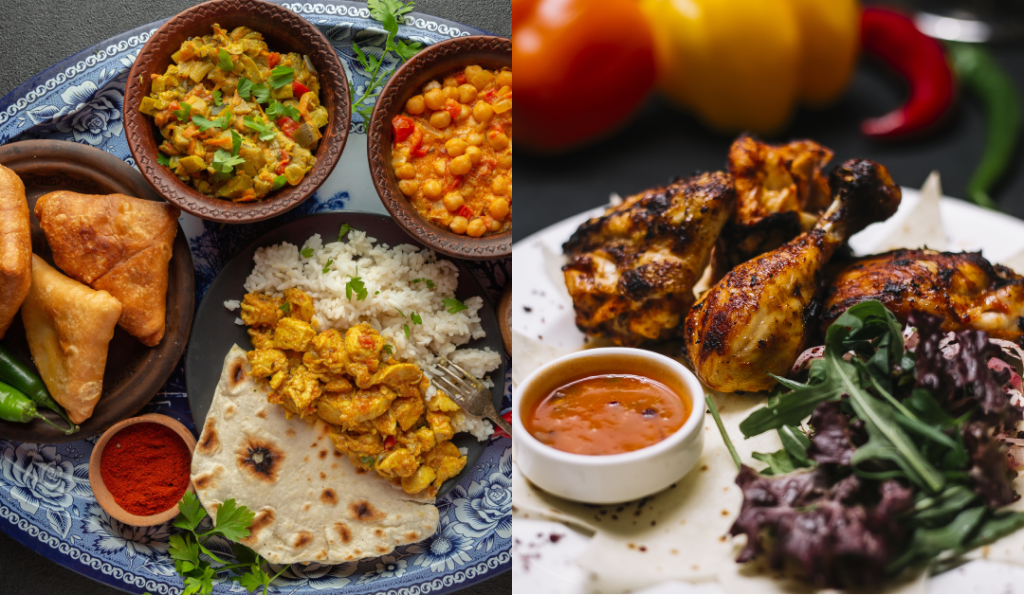Indian and Pakistani cuisines are renowned for their rich flavors, aromatic spices, and diverse range of dishes that reflect the cultural and historical heritage of the respective countries. While there are many similarities due to shared history and geography, distinct differences set them apart, making each cuisine unique in its own right.
Historical and Geographical Influences
Both cuisines have evolved under similar historical influences, including Mughal, Persian, and local traditions.
The partition of British India in 1947 led to the creation of India and Pakistan, separating a once unified culinary tradition. However, regional cooking styles in both countries often have more in common with each other than with the cuisines of their distant regions.
Similarities
- Use of Spices: Both cuisines are known for their generous use of spices like cumin, coriander, cardamom, and turmeric, which give the dishes their characteristic flavors and aromas.
- Popular Dishes: Many dishes are common to both countries, such as biryani (a spiced rice and meat dish), kebabs (grilled meat), and roti or naan (types of bread).
- Cooking Techniques: Slow cooking methods like dum (steaming over a low flame), and tandoori (cooking in a clay oven) are prevalent in both cuisines, enhancing the flavors of the dishes.
Differences
- Meat Preferences: While both cuisines offer a variety of meat dishes, there is a notable difference in preference. Pakistani cuisine predominantly features beef and chicken, aligning with the Islamic dietary laws. In contrast, Indian cuisine includes a wider variety of meats, including chicken, mutton, and pork, catering to the diverse religious practices in the country.
- Vegetarian Dishes: India has a significant vegetarian population, which has led to a diverse range of vegetarian and vegan dishes, such as dal (lentils), paneer (cottage cheese) dishes, and vegetable curries. Pakistani cuisine, while offering vegetarian options, is more centered around meat dishes.
- Regional Influences: Pakistani cuisine has a strong influence from Central Asian and Middle Eastern cooking styles, particularly in the use of meats and bread. Indian cuisine, on the other hand, shows a broader range of influences, including Persian, Southeast Asian, and British, resulting in a wider variety of flavors and ingredients.
- Dairy Usage: Indian cuisine makes extensive use of dairy products like milk, cream, paneer, and ghee (clarified butter). In Pakistani cuisine, while dairy is used, it is not as predominant as in Indian dishes.
- Spice Levels and Flavor Profiles: Although both cuisines are known for their spiciness, Indian food often has a more complex layering of flavors with a balance of sweet, sour, spicy, and savory, achieved through the use of various spices and ingredients like tamarind and amchur (dry mango powder). Pakistani dishes tend to focus more on robust and rich flavors, with a greater emphasis on the meat’s natural tastes and fewer sour elements.
While Indian and Pakistani cuisines share many commonalities due to their shared heritage, they have also diverged significantly, reflecting the diverse cultural, religious, and regional influences of each country. Both cuisines offer a rich gastronomic experience, with an array of dishes that range from spicy kebabs to flavorful vegetarian curries, showcasing the art of cooking with spices and the importance of food in their cultural traditions. Whether you are savoring a succulent Pakistani biryani or indulging in an Indian paneer tikka, the depth and variety in both cuisines are a testament to the rich culinary heritage of the Indian subcontinent.

